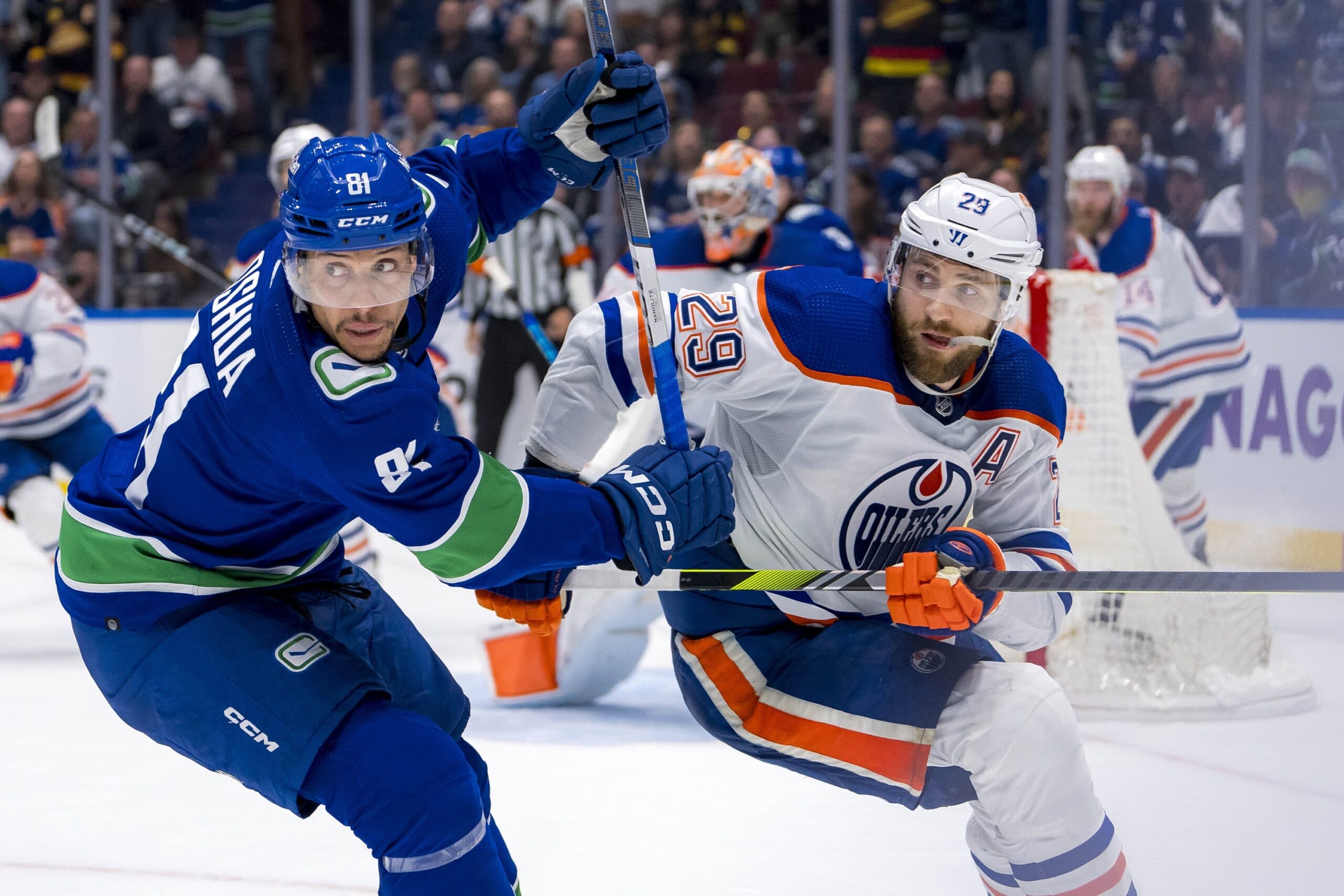Nation Sites
The Nation Network
CanucksArmy has no direct affiliation to the Vancouver Canucks, Canucks Sports & Entertainment, NHL, or NHLPA
Have the Oilers’ massive contracts set them up to be surpassed by the Canucks?

Photo credit: © Bob Frid-Imagn Images
Sep 4, 2024, 11:20 EDTUpdated: Sep 5, 2024, 10:46 EDT
The largest per year contract in NHL history – so far, anyway – just got handed out in the province next door. The Edmonton Oilers have extended Leon Draisaitl with an eight-year, $14 million AAV contract that will kick in as of the 2025/26 season.
And any way you slice it, that’s a lot of cash.
There really isn’t much debate to be had about whether or not Draisaitl deserves that contract, which is to say that if anyone does, it’s him and a very small group of equally elite players. Over the past five seasons, Draisaitl’s eye-popping 538 points in 368 games ranks second among NHL scorers, behind only teammate Connor McDavid.
It’s a considerable amount more scoring than the 444 points in 350 games offered up by Auston Matthews – the previous highest-paid player in the NHL at a $13.25 million AAV.
As for the argument that Draisaitl shouldn’t be paid more than McDavid, that’s all well and good, but the reality is that McDavid signed his own current $12.5 million AAV contract way back in 2018. At the time, McDavid’s salary represented 15.72% of the total cap space available. Draisaitl’s contract will fall into the same range of percentages when it kicks in, due to the cap having risen once again by the start of the 2025/26 campaign.
But make no mistake – when McDavid’s own extension comes due as of 2026, he will be making more money than Draisaitl, or anyone else in the NHL for that matter. Which is, in a roundabout way, what we’re here to talk about today.
Starting with the 2025/26 season, the Oilers are going to have a massive amount of their cap space dedicated to a very select handful of players.
A full $14 million is now committed to Draisaitl. McDavid will still be at $12.5 million at that point, but just one year away from a significant raise. On their own, neither of those amounts are necessarily a problem.
The issue comes more in the form of Darnell Nurse, who is on the books at a $9.25 million AAV from now until the year 2028.
No matter what opinion one holds of Nurse, there’s just no way he is worth that salary. He might not even be worth half of it. During the Oilers’ run to the Cup Finals last year, Nurse ranked just fourth on their blueline in average ice-time with 18:50, a number that declined the longer the playoffs rolled on. For a bit of perspective, Vincent Desharnais – whom the Vancouver Canucks just signed for a $2 million AAV – ranked just behind Nurse on that same run with a 17:50 average ice-time.
And that’s a problem. As soon as the 2025/26 season begins, the Oilers will have a grand total of $35.75 million committed to just three players, two of whom are unparalleled superstars and one of whom is barely a top-four defender.
The cap ceiling is rising by $4.5 million for the 2024/25 season, up to $88 million. Assuming it rises a similar amount this next summer, it could be at around $92.5 million for 2025/26. That sets the Oilers’ trio at a staggering 38.6% of the cap, and leaves just $56.75 million for the other 18-20 players needed on the roster.
And that’s not even mentioning Evan Bouchard, due to become a restricted free agent at the conclusion of this upcoming season. Last year, Bouchard broke all the way out with 82 points in 81 regular season games, and then followed that up with a nearly-record-breaking 32 points in 25 playoff games.
Unless his play completely falls off a cliff over the next couple of months, there’s no real reason for Bouchard to accept anything less than the $9.25 million AAV that Nurse currently holds – and plenty of reason to ask for more.
If we slot Bouchard in at a nice, round $10 million AAV on his next extension, you’ve suddenly got the Oilers up to an estimated $47.75 million spent on four players as of the 2025/26 season. That’s over half of the projected cap.
This is where we bring things back, as we always do, to the topic of the Vancouver Canucks, by way of the discussion of competitive windows.
The Canucks rose in the rankings by a considerable margin last season. But despite making a real contest out of Round Two, at no point did the Canucks surpass the Oilers in anyone’s mind. Vancouver may have won the Pacific Division in the regular season, but they still entered into their series with the Oilers as the heavy underdogs.
The question, then, is whether or not all these enormous contracts will weigh the Oilers down enough for the Canucks to surpass them – without having to wait for McDavid and Draisaitl to exit their natural primes.
It seems like a distinct possibility. Maybe not next year, as the Oilers’ next two big cap hits won’t kick in until the 2025/26 season. But beyond that point? Roster construction becomes very difficult for the Oilers moving forward, with an average of around $2 million left to spend on every other player on their team.
The situation is made even more dire by the Oilers’ overall lack of youth. Get this: the youngest forward on the Oilers’ current projected roster is former Canuck Vasily Podkolzin at 23. The second-youngest forward, however, is McDavid at 27. That says a lot about where the Oilers are at now, and moving forward.
The Canucks, meanwhile, have their own top two centres locked in at a cumulative rate of $19.6 million for the next four seasons running. And, no, Elias Pettersson and JT Miller are nowhere near the equivalent of McDavid and Draisaitl. But by the time McDavid’s own extension gets signed, the Oilers may very well be paying their duo $10 million more per season than the Canucks pay Pettersson and Miller.
And then there is Quinn Hughes, probably a better defender than Bouchard and Nurse combined, locked in an absolute bargain rate of $7.85 million for the next three seasons.
By the time the 2025/26 season begins, the Oilers will be paying their four highest-paid players a total of about $47.75 million. The Canucks’ fourth-highest-paid player at that point will be either Filip Hronek at $7.25 million or perhaps a re-signed Brock Boeser. Either way, that’s a total of $34.75 million.
In comparing foursomes, it’s hard not to look at McDavid/Draisaitl/Bouchard/Nurse versus Hughes/Pettersson/Miller/Hronek as at least a dead heat, and maybe even an edge to the Canucks.
All of which sets the Canucks up nicely to surpass the Oilers as the Pacific Division’s top contender. That probably doesn’t happen in the upcoming 2024/25 season, with Edmonton getting a one-year reprieve before their financial situation tightens up considerably. But as of 2025/26, cap space becomes an everyday issue in Edmonton, whereas the Canucks remain sitting pretty.
Sure, Hughes is due his own presumably-gargantuan extension in the summer of 2027. But that still gives the Canucks a two-season window – the 2025/26 and 2026/27 seasons – in which they have a very real chance to leapfrog the Oilers and stay ahead of them.
At the same time, there’s little challenge from elsewhere in the Pacific. The Vegas Golden Knights remain loaded with talent, but are already deeply mired in their own cap concerns amid a core of rapidly-aging players. The Los Angeles Kings once looked like a future threat, but have suffered through mismanagement. The Calgary Flames are stuck in a non-competitive no-man’s land. The San Jose Sharks, Anaheim Ducks, and Seattle Kraken are all far enough back in their various builds to all but ensure they won’t be competing by 2027.
Of course, this is all a little speculative, and a lot can change over the course of two years. But speaking of courses, it is possible to look at the latest contracts handed out or about to be handed out by the Oilers, and chart a course to those contracts weighing them down just enough for the Canucks to surpass them.
Sponsored by bet365
Breaking News
- Canucks trade rumours: Flyers said no to a trade involving Owen Tippett
- Canucks: Quinn Hughes and Adam Foote address on-ice frustrations
- Scenes from practice: Höglander a full participant, Karlsson stays on Canucks’ top line
- Canucks injury updates: Höglander and Demko could return vs. Sabres next Thursday
- Canucks roster news: Nikita Tolopilo and defenceman Elias Pettersson recalled from AHL
